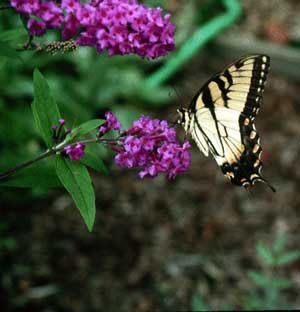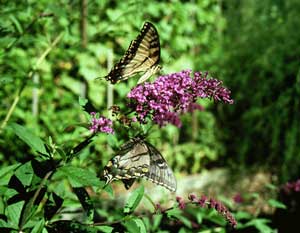Butterfly Bush (Buddleia)
 |
An increasingly popular flowering shrub for residential yards and gardens, the butterfly bush deserves its reputation for vigorous growth, colorful, reliable blooms and resistance to pest problems. Also known as summer lilac, this shrub was introduced into the United States from China around 1900. Since then many varieties have been developed and it is grown all over the country. A butterfly bush is easy to care for and has no serious pest or disease problems. As its name suggests, it is a favorite of butterflies which eagerly visit while it is in bloom. In fact, it is at the top of any list of plants that attract butterflies. The davidii types are most popular and are easy to find in many colors.
Size: While they are capable of growing from 10 to 15 feet tall, butterfly bushes typically grow from 6 to 8 feet tall over one season because most are cut back to the soil each year. They grow virtually as wide as they are tall. Monrovia Nurseries Petite Series released in 2003 are dwarf, growing to only 4 or 5 feet tall.
Foliage: Butterfly bush foliage is deciduous, dropping off in the fall. Leaves are coarse-textured, but subdued in appearance. Individual ones are broadly lance-shaped, usually from 4 to 12 inches long and 1 to 3 inches wide. They are a dull, bluish or grayish-green on top and pale, almost silvery, underneath. They have smooth edges and rounded tips and grow opposite each other along the stems. One type of butterfly bush has variegated foliage with irregular creamy-white edges. While their foliage occasionally turns yellow in autumn before it drops, butterfly bushes do not have any ornamental fall foliage color.
 |
Flowers and Fruit: The flowers on a butterfly bush are made up lots of tiny florets that have orange centers. They form tubular clusters resembling narrow lilac blooms. These clusters may be anywhere from 4 inches to 10 inches long, sometimes growing upright, sometimes drooping somewhat from the tips of the branches. Blossoms are fragrant and may be lilac, purple, blue, shades of pink or red, or white. Flowers begin to appear in early to mid-summer, appearing steadily until frost. During the season as each blossom fades it gives way to 1/4 to 1/3 inch long dried capsules which have no ornamental value. Clip these off as they form to encourage more new blossoms.

